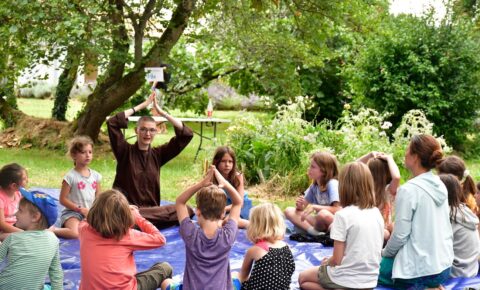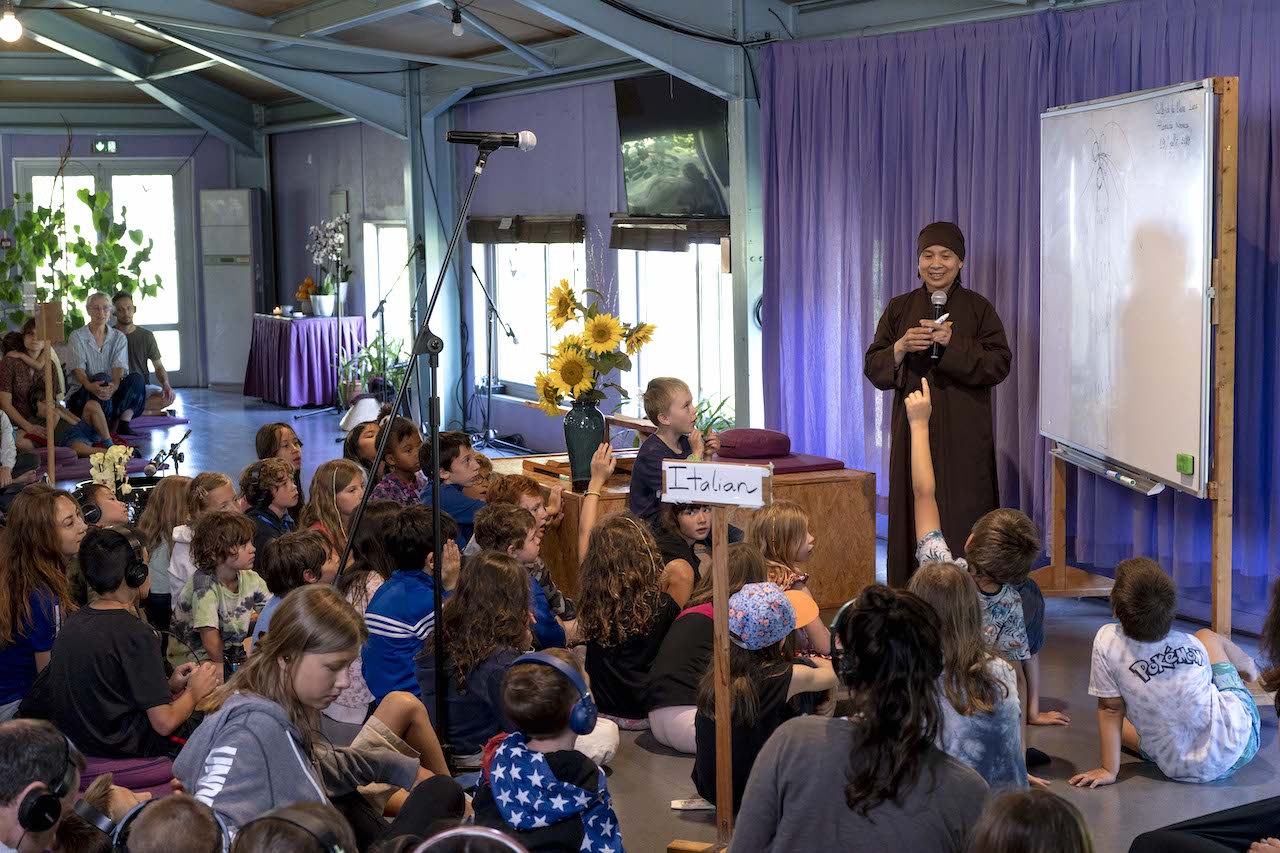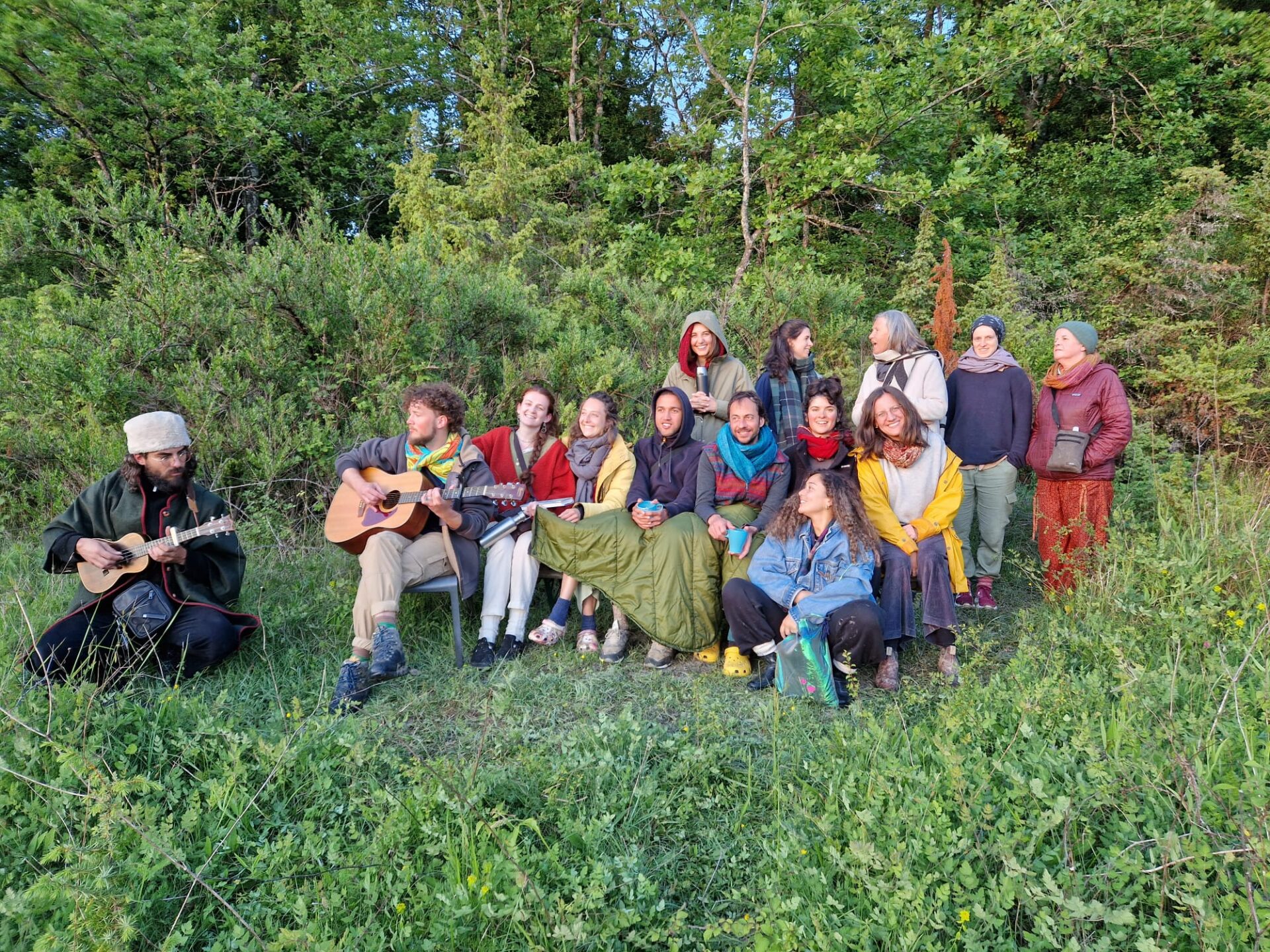Writing Old Path White Clouds
During the Summer Opening in the first years, I stayed in the room above the bookshop in Upper Hamlet. We had very few rooms then, and I had to share the room with four or five children. They stayed in the room with me and at night they sprawled out on the floor.
I thought that children needed to sing; that chanting alone was not enough. I intended to write the song, “I take refuge in the Buddha, the one who shows me the way in this life…” for the children. One afternoon we did sitting meditation in the Bamboo Hall. The walls are made of stone. Facing a big block of stone, the tune for the song came to me. “I take refuge in the Buddha, the one who shows me the way in this life, Namo Buddhaya.” I thought to myself, “I am here to do sitting meditation and not to make up songs. Let’s continue it after the sitting meditation. ”How-ever, after a few minutes, the music returned to me. I thought, “If it’s going to be like this, I might as well compose the song now.” So I continued writing that song and, after the meditation, I recorded it in order not to forget it.
At that time I was also writing the book Old Path White Clouds. We did not have central heating yet, only a wood stove in the little room above the bookshop, and the weather was very cold. I wrote with my right hand, and I put my left hand out over the stove. I was very happy writing. From time to time, I would stand up and make myself a cup of tea. Every day, the few hours I spent writing was like sitting with the Buddha for a cup of tea. I knew that the readers would have much happiness while reading the book because I had so much happiness while writing it.
Writing Old Path White Clouds was not hard work; rather, it was an immense joy. It was also a time of discovery. Some sections were more difficult to write than others. One difficult section was when the Buddha first gave teachings to the three Kashyapa brothers and received them as disciples. There are documents that say the Buddha had to use miracles to do it, but I wanted to show that he did it with his compassion and understanding. The Buddha has a great capacity of understanding and compassion, so why would he have to use miraculous powers? I had a strong faith that I would be able to write the chapter in that light. That was the most difficult chapter for me, but eventually succeeded. The second most difficult chapter was when the Buddha went back to visit his family after becoming enlightened. He was still the son of his parents and a brother to his siblings. I wished to write in a way that would retain his human qualities. The way he took the hand of his father upon their meeting, the way he related with his younger sister, with Yasodhara and Rahula, was very natural. I could only write in that way because I felt the ancestral teachers supporting me. In reading Old Path White Clouds, we find that Buddha is a human being and not a god. That is precisely the aim, to help readers rediscover the Buddha as a human being. I tried to take away the mystic halos people ascribe to the Buddha. Not being able to see the Buddha as a human being makes it difficult for us to approach the Buddha.
The First Blossoms Of Awakening
I became a monk in Vietnam. I grew up in Vietnam. I learned and practiced Buddhism in Vietnam. Before coming to the West, I taught several generations of Buddhist students in Vietnam. But I can say that I realized the path in the West. In 1962, at Princeton Theological Seminary, where I was invited to teach, I began to have many deep insights, flowers and fruits of the practice. If you have read my journal, Fragrant Palm Leaves, you will see that, for me, going to Princeton was like going into a monastery. It was far from the pressing demands of the current situation in Vietnam. I had much time to do walking meditation, assisting the maturation of insights that had not yet ripened.
I wrote A Rose for Your Pocket in the summer of 1962 at Princeton. It is a simple little book, but it is, in fact, the fruit of my awakening. In it, the practice of “dwelling happily in the present moment” is first described. We need to live in a way that does not allow the wonderful things in life to slip through our fingers. We need to live deeply, present for each moment. This is what is contained in A Rose for Your Pocket. It can be considered the first blossom of my awakening. Since then, that insight has continued on its path of deepening.
The shortest and most profound Dharma talk I can give is, “I have arrived. I am home.” Only six words, “I have arrived. I am home,” can be considered the Dharma Seal of Plum Village. Any Dharma talk, any teaching that goes against the spirit of “I have arrived, I am home” is not truly a teaching or method of practice of Plum Village. This Dharma Seal was first expressed in A Rose for Your Pocket.
In 1974, while I was working for peace in Paris, I wrote The Miracle of Mindfulness. I wrote it out of love for my monastic and lay students, young social workers working in Vietnam in the dangerous circumstances of wartime. After it was written, I sent it to Vietnam to be published, and it was translated in to English. This book teaches us how to dwell in the present moment and to live mindfully with awareness of what is happening within us and around us. Between writing A Rose for Your Pocket in 1962 and The Miracle of Mindfulness in 1974, there were twelve years, you can recognize the progressive change in my way of looking at things. That was the process of the blooming of the lotus.
In my life of practice, I have had the opportunity to bring Buddhism back to the original teachings of the Buddha. Before this, I had the insight about dwelling happily in the present moment. Once back in the stream of the original teachings, that insight was experienced fully and with more clarity.
The Miracle of Mindfulness was published by Beacon Press, and now, more than two decades later, it continues to sell very well. The Miracle of Mindfulness is a meditation guide to use if you want to share the Plum Village style of practice with people. It has been translated into at least thirty languages.
Mindfulness is the basic meditation practice in Plum Village. Mindfulness means dwelling in the present moment to become aware of the positive and negative elements that are there. We learn to nourish the positive and to transform the negative. Twenty years of Plum Village life has helped me to learn so much and has helped the Sangha of Plum Village to grow up so much.






Join the conversation